Research Methodology: Educating Indian Migrants in Green Construction
VerifiedAdded on 2021/04/21
|12
|3794
|24
Report
AI Summary
This report presents a comprehensive overview of the research methodology employed to investigate the challenges of educating Indian migrants in the green building construction industry. The study utilizes secondary data collection methods, focusing on existing literature and statistical data related to green construction and migrant workers. The research adopts an interpretivism philosophy, considering both social and scientific aspects, and employs a deductive approach to evaluate the core challenges faced by Indian migrants. The meta-analysis design and likelihood sampling method are used. The report details the rationale for selecting secondary data, emphasizing its efficiency and ability to provide a global context. It discusses the significance of the methodology, including philosophy (interpretivism vs. positivism), research approach (deductive vs. inductive), and data collection methods (primary vs. secondary, qualitative vs. quantitative). The report also includes a table of sources, keywords, and descriptions of each source used in the research.
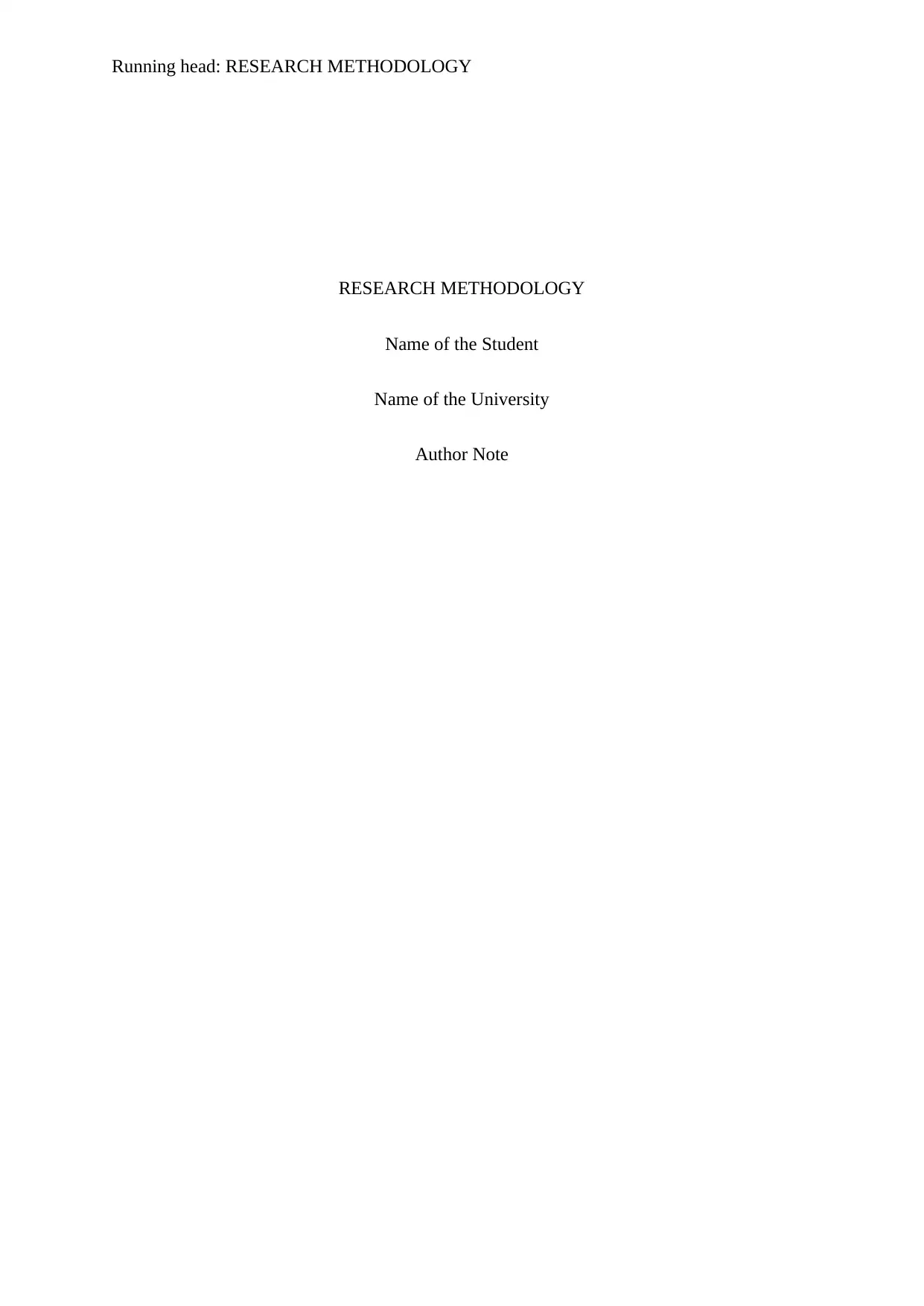
Running head: RESEARCH METHODOLOGY
RESEARCH METHODOLOGY
Name of the Student
Name of the University
Author Note
RESEARCH METHODOLOGY
Name of the Student
Name of the University
Author Note
Paraphrase This Document
Need a fresh take? Get an instant paraphrase of this document with our AI Paraphraser
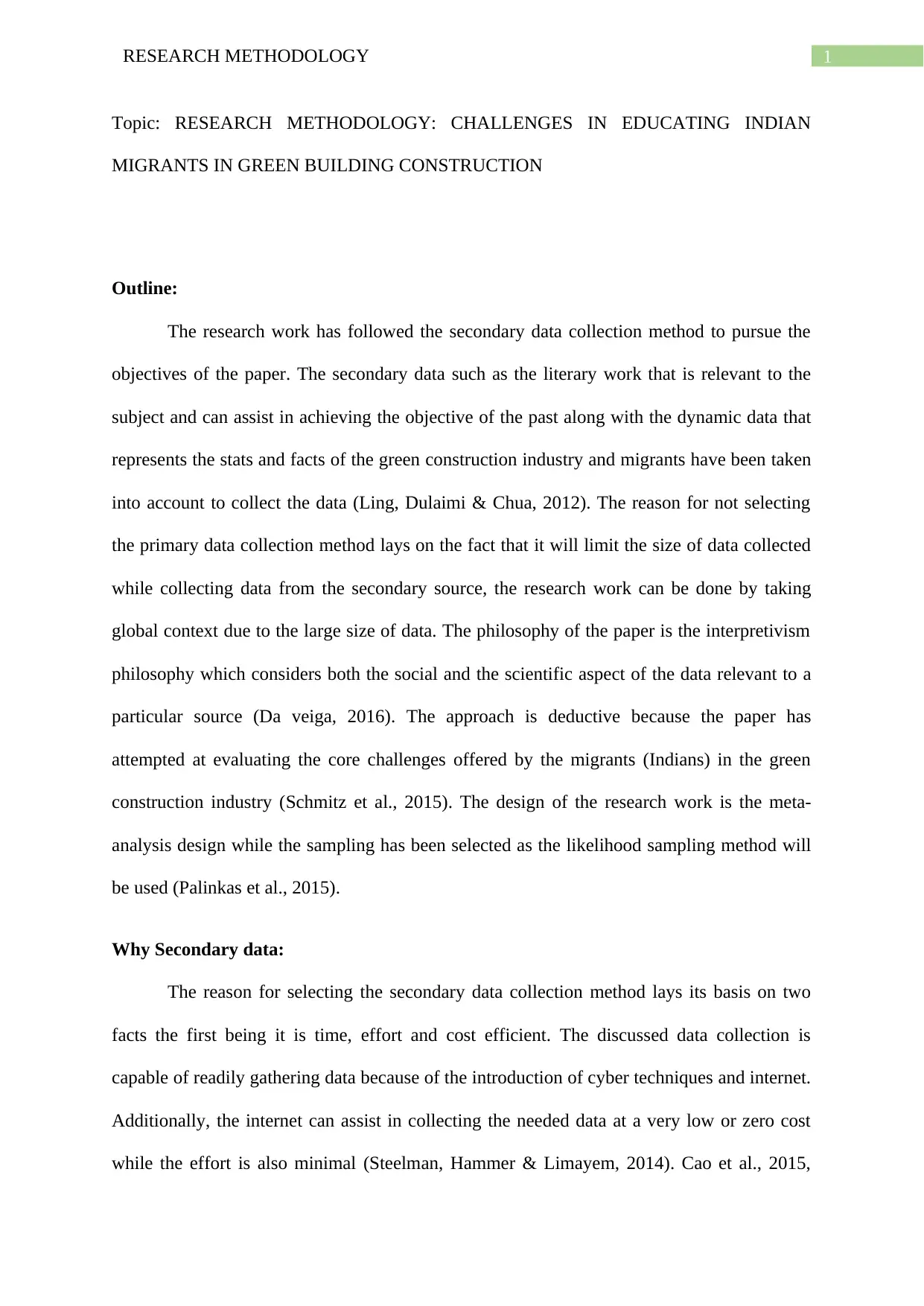
1RESEARCH METHODOLOGY
Topic: RESEARCH METHODOLOGY: CHALLENGES IN EDUCATING INDIAN
MIGRANTS IN GREEN BUILDING CONSTRUCTION
Outline:
The research work has followed the secondary data collection method to pursue the
objectives of the paper. The secondary data such as the literary work that is relevant to the
subject and can assist in achieving the objective of the past along with the dynamic data that
represents the stats and facts of the green construction industry and migrants have been taken
into account to collect the data (Ling, Dulaimi & Chua, 2012). The reason for not selecting
the primary data collection method lays on the fact that it will limit the size of data collected
while collecting data from the secondary source, the research work can be done by taking
global context due to the large size of data. The philosophy of the paper is the interpretivism
philosophy which considers both the social and the scientific aspect of the data relevant to a
particular source (Da veiga, 2016). The approach is deductive because the paper has
attempted at evaluating the core challenges offered by the migrants (Indians) in the green
construction industry (Schmitz et al., 2015). The design of the research work is the meta-
analysis design while the sampling has been selected as the likelihood sampling method will
be used (Palinkas et al., 2015).
Why Secondary data:
The reason for selecting the secondary data collection method lays its basis on two
facts the first being it is time, effort and cost efficient. The discussed data collection is
capable of readily gathering data because of the introduction of cyber techniques and internet.
Additionally, the internet can assist in collecting the needed data at a very low or zero cost
while the effort is also minimal (Steelman, Hammer & Limayem, 2014). Cao et al., 2015,
Topic: RESEARCH METHODOLOGY: CHALLENGES IN EDUCATING INDIAN
MIGRANTS IN GREEN BUILDING CONSTRUCTION
Outline:
The research work has followed the secondary data collection method to pursue the
objectives of the paper. The secondary data such as the literary work that is relevant to the
subject and can assist in achieving the objective of the past along with the dynamic data that
represents the stats and facts of the green construction industry and migrants have been taken
into account to collect the data (Ling, Dulaimi & Chua, 2012). The reason for not selecting
the primary data collection method lays on the fact that it will limit the size of data collected
while collecting data from the secondary source, the research work can be done by taking
global context due to the large size of data. The philosophy of the paper is the interpretivism
philosophy which considers both the social and the scientific aspect of the data relevant to a
particular source (Da veiga, 2016). The approach is deductive because the paper has
attempted at evaluating the core challenges offered by the migrants (Indians) in the green
construction industry (Schmitz et al., 2015). The design of the research work is the meta-
analysis design while the sampling has been selected as the likelihood sampling method will
be used (Palinkas et al., 2015).
Why Secondary data:
The reason for selecting the secondary data collection method lays its basis on two
facts the first being it is time, effort and cost efficient. The discussed data collection is
capable of readily gathering data because of the introduction of cyber techniques and internet.
Additionally, the internet can assist in collecting the needed data at a very low or zero cost
while the effort is also minimal (Steelman, Hammer & Limayem, 2014). Cao et al., 2015,
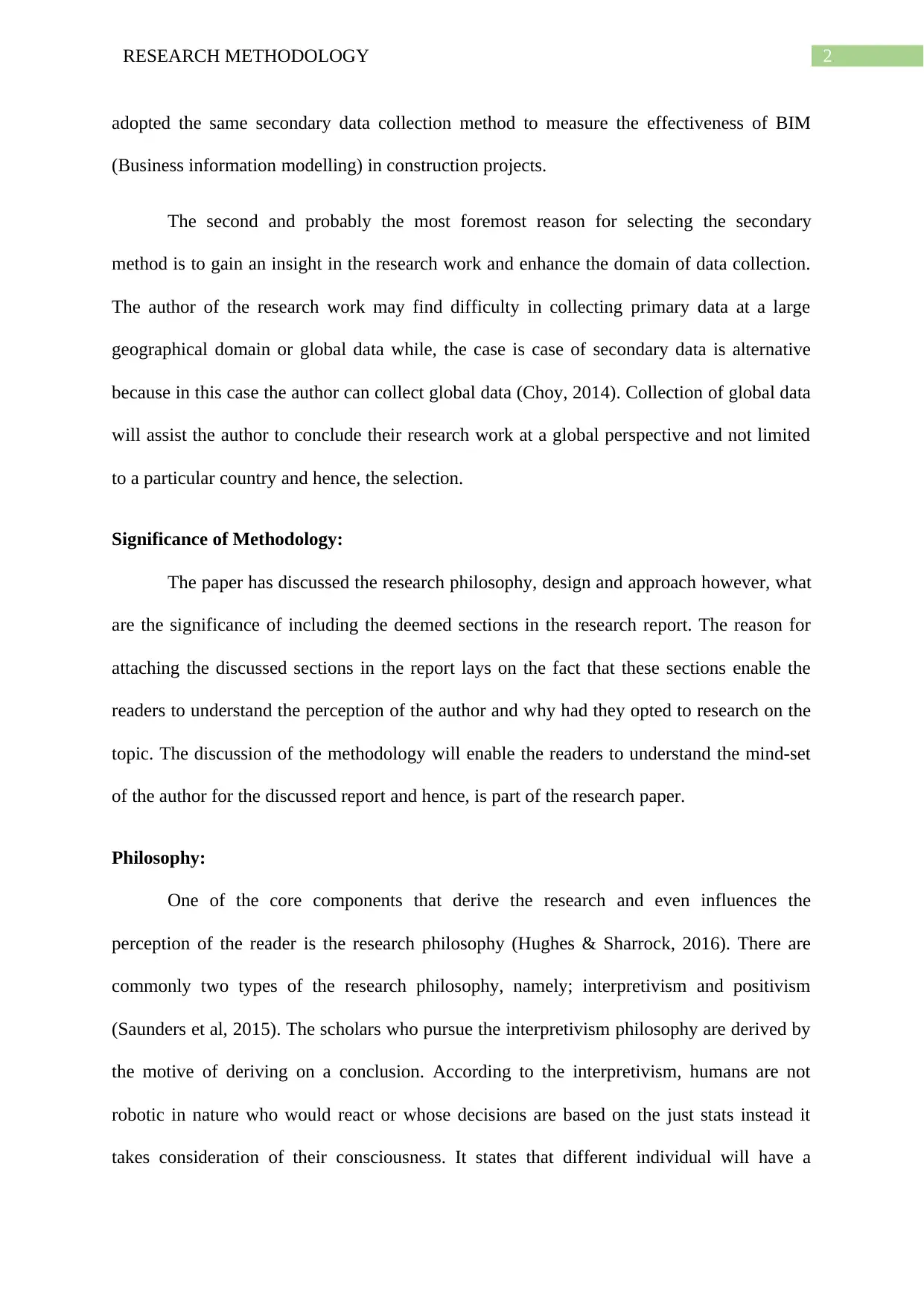
2RESEARCH METHODOLOGY
adopted the same secondary data collection method to measure the effectiveness of BIM
(Business information modelling) in construction projects.
The second and probably the most foremost reason for selecting the secondary
method is to gain an insight in the research work and enhance the domain of data collection.
The author of the research work may find difficulty in collecting primary data at a large
geographical domain or global data while, the case is case of secondary data is alternative
because in this case the author can collect global data (Choy, 2014). Collection of global data
will assist the author to conclude their research work at a global perspective and not limited
to a particular country and hence, the selection.
Significance of Methodology:
The paper has discussed the research philosophy, design and approach however, what
are the significance of including the deemed sections in the research report. The reason for
attaching the discussed sections in the report lays on the fact that these sections enable the
readers to understand the perception of the author and why had they opted to research on the
topic. The discussion of the methodology will enable the readers to understand the mind-set
of the author for the discussed report and hence, is part of the research paper.
Philosophy:
One of the core components that derive the research and even influences the
perception of the reader is the research philosophy (Hughes & Sharrock, 2016). There are
commonly two types of the research philosophy, namely; interpretivism and positivism
(Saunders et al, 2015). The scholars who pursue the interpretivism philosophy are derived by
the motive of deriving on a conclusion. According to the interpretivism, humans are not
robotic in nature who would react or whose decisions are based on the just stats instead it
takes consideration of their consciousness. It states that different individual will have a
adopted the same secondary data collection method to measure the effectiveness of BIM
(Business information modelling) in construction projects.
The second and probably the most foremost reason for selecting the secondary
method is to gain an insight in the research work and enhance the domain of data collection.
The author of the research work may find difficulty in collecting primary data at a large
geographical domain or global data while, the case is case of secondary data is alternative
because in this case the author can collect global data (Choy, 2014). Collection of global data
will assist the author to conclude their research work at a global perspective and not limited
to a particular country and hence, the selection.
Significance of Methodology:
The paper has discussed the research philosophy, design and approach however, what
are the significance of including the deemed sections in the research report. The reason for
attaching the discussed sections in the report lays on the fact that these sections enable the
readers to understand the perception of the author and why had they opted to research on the
topic. The discussion of the methodology will enable the readers to understand the mind-set
of the author for the discussed report and hence, is part of the research paper.
Philosophy:
One of the core components that derive the research and even influences the
perception of the reader is the research philosophy (Hughes & Sharrock, 2016). There are
commonly two types of the research philosophy, namely; interpretivism and positivism
(Saunders et al, 2015). The scholars who pursue the interpretivism philosophy are derived by
the motive of deriving on a conclusion. According to the interpretivism, humans are not
robotic in nature who would react or whose decisions are based on the just stats instead it
takes consideration of their consciousness. It states that different individual will have a
⊘ This is a preview!⊘
Do you want full access?
Subscribe today to unlock all pages.

Trusted by 1+ million students worldwide
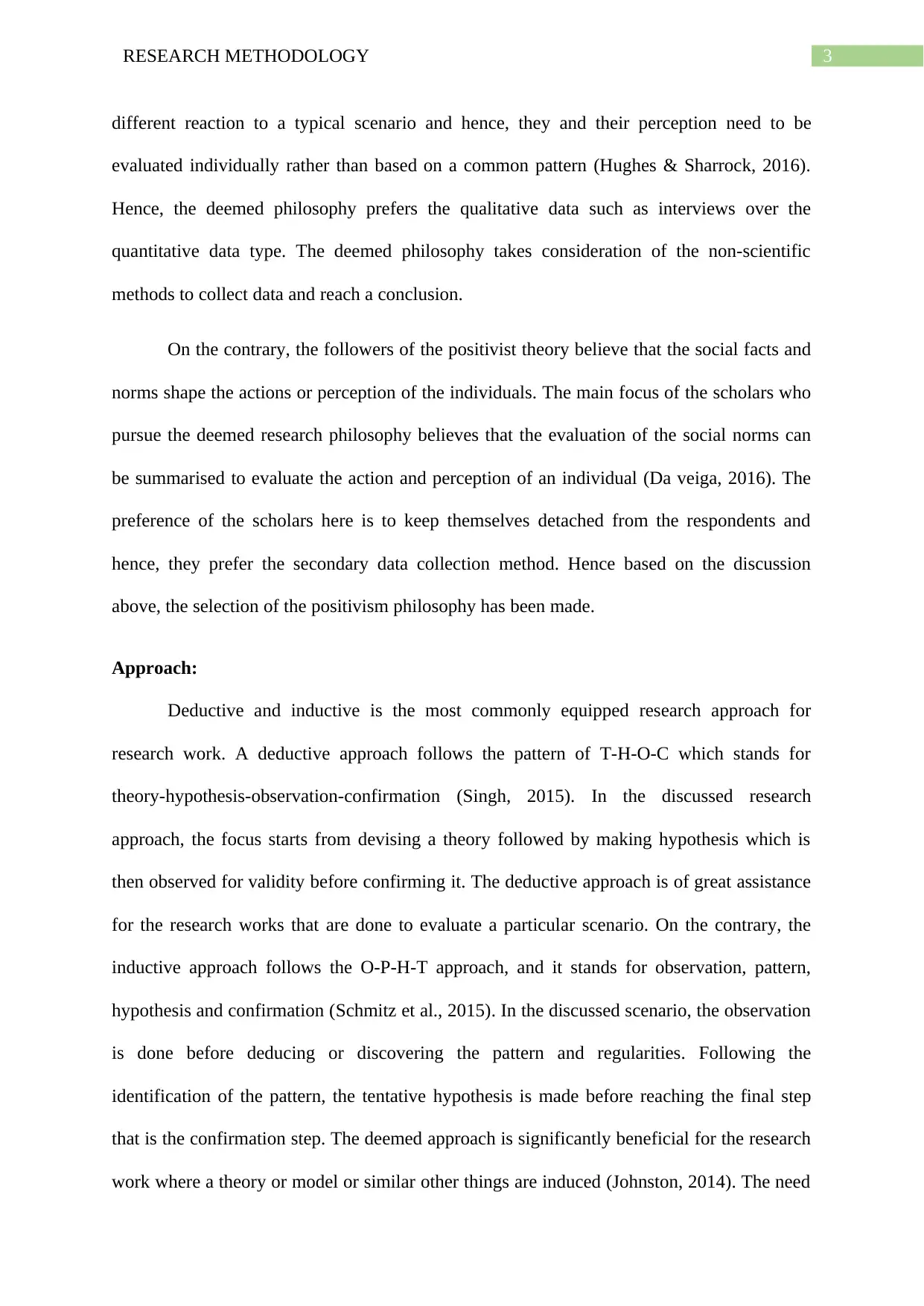
3RESEARCH METHODOLOGY
different reaction to a typical scenario and hence, they and their perception need to be
evaluated individually rather than based on a common pattern (Hughes & Sharrock, 2016).
Hence, the deemed philosophy prefers the qualitative data such as interviews over the
quantitative data type. The deemed philosophy takes consideration of the non-scientific
methods to collect data and reach a conclusion.
On the contrary, the followers of the positivist theory believe that the social facts and
norms shape the actions or perception of the individuals. The main focus of the scholars who
pursue the deemed research philosophy believes that the evaluation of the social norms can
be summarised to evaluate the action and perception of an individual (Da veiga, 2016). The
preference of the scholars here is to keep themselves detached from the respondents and
hence, they prefer the secondary data collection method. Hence based on the discussion
above, the selection of the positivism philosophy has been made.
Approach:
Deductive and inductive is the most commonly equipped research approach for
research work. A deductive approach follows the pattern of T-H-O-C which stands for
theory-hypothesis-observation-confirmation (Singh, 2015). In the discussed research
approach, the focus starts from devising a theory followed by making hypothesis which is
then observed for validity before confirming it. The deductive approach is of great assistance
for the research works that are done to evaluate a particular scenario. On the contrary, the
inductive approach follows the O-P-H-T approach, and it stands for observation, pattern,
hypothesis and confirmation (Schmitz et al., 2015). In the discussed scenario, the observation
is done before deducing or discovering the pattern and regularities. Following the
identification of the pattern, the tentative hypothesis is made before reaching the final step
that is the confirmation step. The deemed approach is significantly beneficial for the research
work where a theory or model or similar other things are induced (Johnston, 2014). The need
different reaction to a typical scenario and hence, they and their perception need to be
evaluated individually rather than based on a common pattern (Hughes & Sharrock, 2016).
Hence, the deemed philosophy prefers the qualitative data such as interviews over the
quantitative data type. The deemed philosophy takes consideration of the non-scientific
methods to collect data and reach a conclusion.
On the contrary, the followers of the positivist theory believe that the social facts and
norms shape the actions or perception of the individuals. The main focus of the scholars who
pursue the deemed research philosophy believes that the evaluation of the social norms can
be summarised to evaluate the action and perception of an individual (Da veiga, 2016). The
preference of the scholars here is to keep themselves detached from the respondents and
hence, they prefer the secondary data collection method. Hence based on the discussion
above, the selection of the positivism philosophy has been made.
Approach:
Deductive and inductive is the most commonly equipped research approach for
research work. A deductive approach follows the pattern of T-H-O-C which stands for
theory-hypothesis-observation-confirmation (Singh, 2015). In the discussed research
approach, the focus starts from devising a theory followed by making hypothesis which is
then observed for validity before confirming it. The deductive approach is of great assistance
for the research works that are done to evaluate a particular scenario. On the contrary, the
inductive approach follows the O-P-H-T approach, and it stands for observation, pattern,
hypothesis and confirmation (Schmitz et al., 2015). In the discussed scenario, the observation
is done before deducing or discovering the pattern and regularities. Following the
identification of the pattern, the tentative hypothesis is made before reaching the final step
that is the confirmation step. The deemed approach is significantly beneficial for the research
work where a theory or model or similar other things are induced (Johnston, 2014). The need
Paraphrase This Document
Need a fresh take? Get an instant paraphrase of this document with our AI Paraphraser
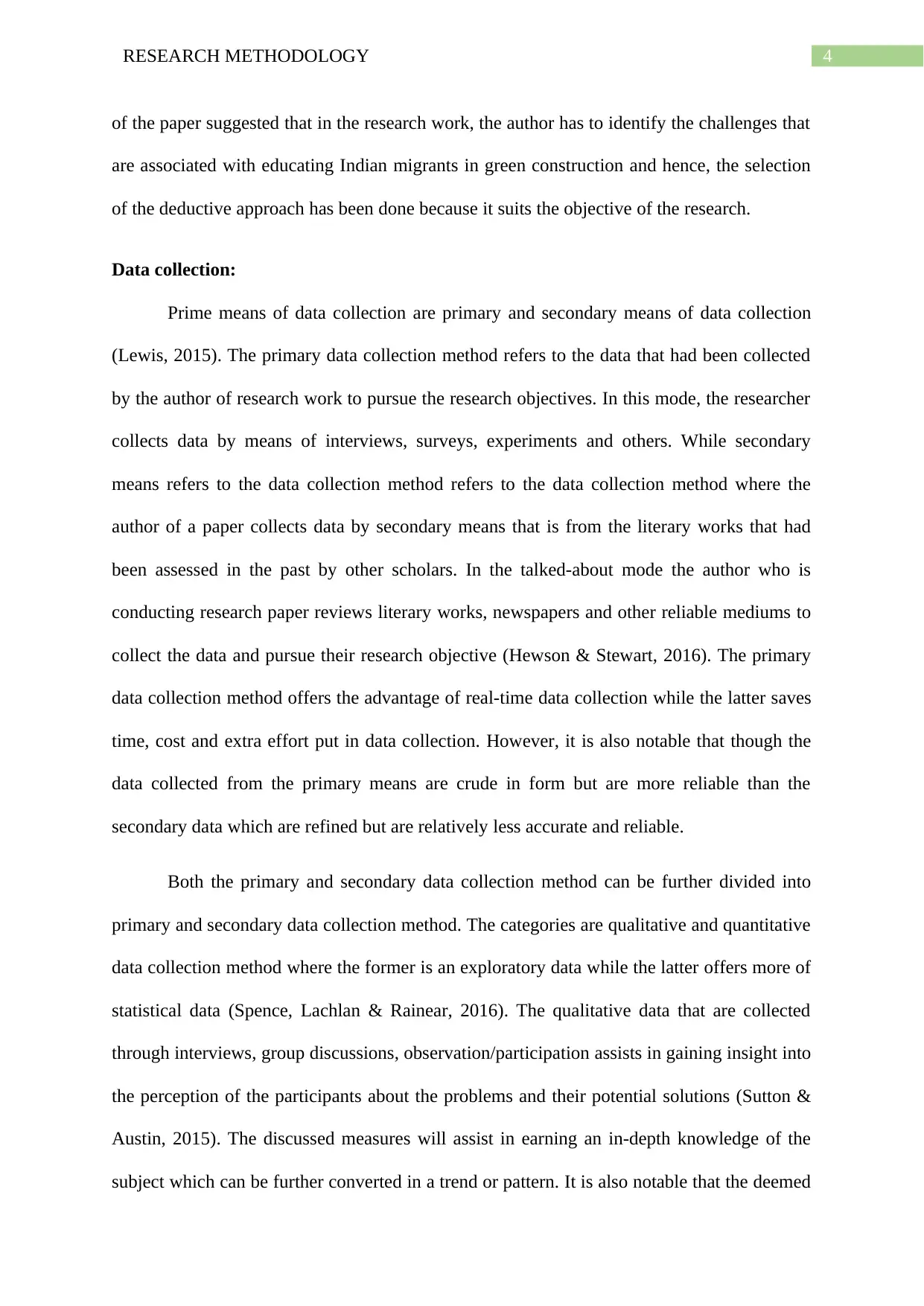
4RESEARCH METHODOLOGY
of the paper suggested that in the research work, the author has to identify the challenges that
are associated with educating Indian migrants in green construction and hence, the selection
of the deductive approach has been done because it suits the objective of the research.
Data collection:
Prime means of data collection are primary and secondary means of data collection
(Lewis, 2015). The primary data collection method refers to the data that had been collected
by the author of research work to pursue the research objectives. In this mode, the researcher
collects data by means of interviews, surveys, experiments and others. While secondary
means refers to the data collection method refers to the data collection method where the
author of a paper collects data by secondary means that is from the literary works that had
been assessed in the past by other scholars. In the talked-about mode the author who is
conducting research paper reviews literary works, newspapers and other reliable mediums to
collect the data and pursue their research objective (Hewson & Stewart, 2016). The primary
data collection method offers the advantage of real-time data collection while the latter saves
time, cost and extra effort put in data collection. However, it is also notable that though the
data collected from the primary means are crude in form but are more reliable than the
secondary data which are refined but are relatively less accurate and reliable.
Both the primary and secondary data collection method can be further divided into
primary and secondary data collection method. The categories are qualitative and quantitative
data collection method where the former is an exploratory data while the latter offers more of
statistical data (Spence, Lachlan & Rainear, 2016). The qualitative data that are collected
through interviews, group discussions, observation/participation assists in gaining insight into
the perception of the participants about the problems and their potential solutions (Sutton &
Austin, 2015). The discussed measures will assist in earning an in-depth knowledge of the
subject which can be further converted in a trend or pattern. It is also notable that the deemed
of the paper suggested that in the research work, the author has to identify the challenges that
are associated with educating Indian migrants in green construction and hence, the selection
of the deductive approach has been done because it suits the objective of the research.
Data collection:
Prime means of data collection are primary and secondary means of data collection
(Lewis, 2015). The primary data collection method refers to the data that had been collected
by the author of research work to pursue the research objectives. In this mode, the researcher
collects data by means of interviews, surveys, experiments and others. While secondary
means refers to the data collection method refers to the data collection method where the
author of a paper collects data by secondary means that is from the literary works that had
been assessed in the past by other scholars. In the talked-about mode the author who is
conducting research paper reviews literary works, newspapers and other reliable mediums to
collect the data and pursue their research objective (Hewson & Stewart, 2016). The primary
data collection method offers the advantage of real-time data collection while the latter saves
time, cost and extra effort put in data collection. However, it is also notable that though the
data collected from the primary means are crude in form but are more reliable than the
secondary data which are refined but are relatively less accurate and reliable.
Both the primary and secondary data collection method can be further divided into
primary and secondary data collection method. The categories are qualitative and quantitative
data collection method where the former is an exploratory data while the latter offers more of
statistical data (Spence, Lachlan & Rainear, 2016). The qualitative data that are collected
through interviews, group discussions, observation/participation assists in gaining insight into
the perception of the participants about the problems and their potential solutions (Sutton &
Austin, 2015). The discussed measures will assist in earning an in-depth knowledge of the
subject which can be further converted in a trend or pattern. It is also notable that the deemed
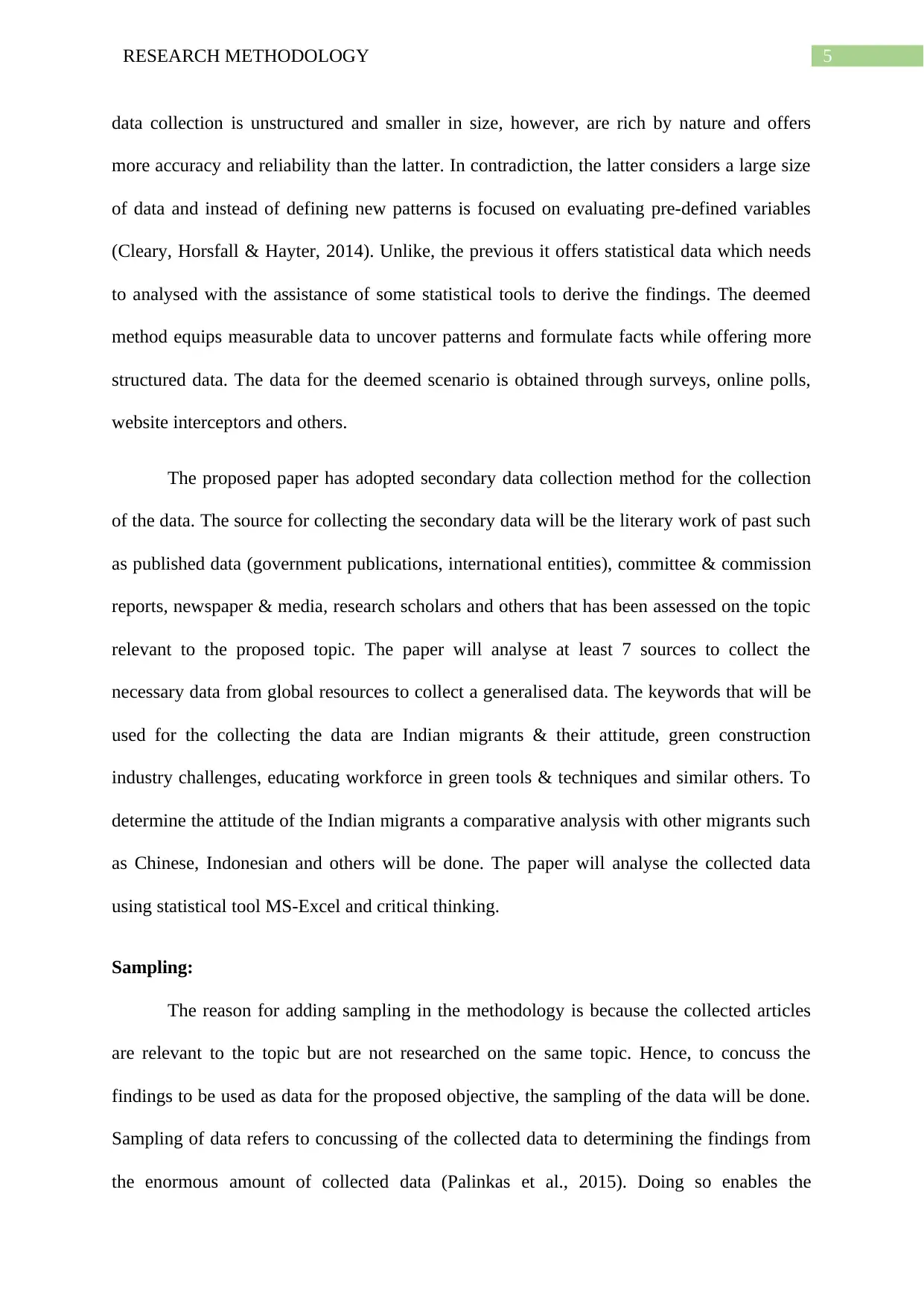
5RESEARCH METHODOLOGY
data collection is unstructured and smaller in size, however, are rich by nature and offers
more accuracy and reliability than the latter. In contradiction, the latter considers a large size
of data and instead of defining new patterns is focused on evaluating pre-defined variables
(Cleary, Horsfall & Hayter, 2014). Unlike, the previous it offers statistical data which needs
to analysed with the assistance of some statistical tools to derive the findings. The deemed
method equips measurable data to uncover patterns and formulate facts while offering more
structured data. The data for the deemed scenario is obtained through surveys, online polls,
website interceptors and others.
The proposed paper has adopted secondary data collection method for the collection
of the data. The source for collecting the secondary data will be the literary work of past such
as published data (government publications, international entities), committee & commission
reports, newspaper & media, research scholars and others that has been assessed on the topic
relevant to the proposed topic. The paper will analyse at least 7 sources to collect the
necessary data from global resources to collect a generalised data. The keywords that will be
used for the collecting the data are Indian migrants & their attitude, green construction
industry challenges, educating workforce in green tools & techniques and similar others. To
determine the attitude of the Indian migrants a comparative analysis with other migrants such
as Chinese, Indonesian and others will be done. The paper will analyse the collected data
using statistical tool MS-Excel and critical thinking.
Sampling:
The reason for adding sampling in the methodology is because the collected articles
are relevant to the topic but are not researched on the same topic. Hence, to concuss the
findings to be used as data for the proposed objective, the sampling of the data will be done.
Sampling of data refers to concussing of the collected data to determining the findings from
the enormous amount of collected data (Palinkas et al., 2015). Doing so enables the
data collection is unstructured and smaller in size, however, are rich by nature and offers
more accuracy and reliability than the latter. In contradiction, the latter considers a large size
of data and instead of defining new patterns is focused on evaluating pre-defined variables
(Cleary, Horsfall & Hayter, 2014). Unlike, the previous it offers statistical data which needs
to analysed with the assistance of some statistical tools to derive the findings. The deemed
method equips measurable data to uncover patterns and formulate facts while offering more
structured data. The data for the deemed scenario is obtained through surveys, online polls,
website interceptors and others.
The proposed paper has adopted secondary data collection method for the collection
of the data. The source for collecting the secondary data will be the literary work of past such
as published data (government publications, international entities), committee & commission
reports, newspaper & media, research scholars and others that has been assessed on the topic
relevant to the proposed topic. The paper will analyse at least 7 sources to collect the
necessary data from global resources to collect a generalised data. The keywords that will be
used for the collecting the data are Indian migrants & their attitude, green construction
industry challenges, educating workforce in green tools & techniques and similar others. To
determine the attitude of the Indian migrants a comparative analysis with other migrants such
as Chinese, Indonesian and others will be done. The paper will analyse the collected data
using statistical tool MS-Excel and critical thinking.
Sampling:
The reason for adding sampling in the methodology is because the collected articles
are relevant to the topic but are not researched on the same topic. Hence, to concuss the
findings to be used as data for the proposed objective, the sampling of the data will be done.
Sampling of data refers to concussing of the collected data to determining the findings from
the enormous amount of collected data (Palinkas et al., 2015). Doing so enables the
⊘ This is a preview!⊘
Do you want full access?
Subscribe today to unlock all pages.

Trusted by 1+ million students worldwide
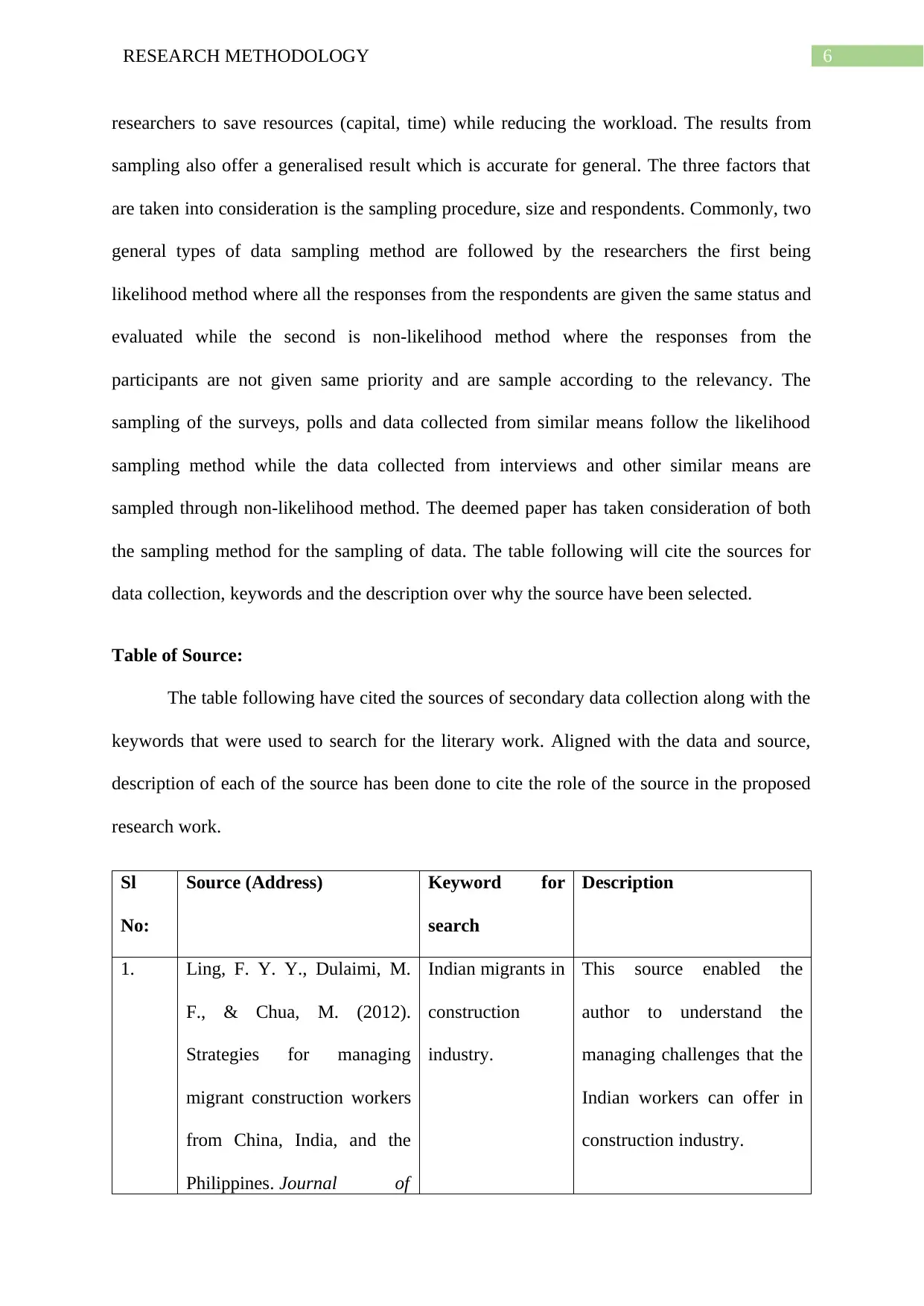
6RESEARCH METHODOLOGY
researchers to save resources (capital, time) while reducing the workload. The results from
sampling also offer a generalised result which is accurate for general. The three factors that
are taken into consideration is the sampling procedure, size and respondents. Commonly, two
general types of data sampling method are followed by the researchers the first being
likelihood method where all the responses from the respondents are given the same status and
evaluated while the second is non-likelihood method where the responses from the
participants are not given same priority and are sample according to the relevancy. The
sampling of the surveys, polls and data collected from similar means follow the likelihood
sampling method while the data collected from interviews and other similar means are
sampled through non-likelihood method. The deemed paper has taken consideration of both
the sampling method for the sampling of data. The table following will cite the sources for
data collection, keywords and the description over why the source have been selected.
Table of Source:
The table following have cited the sources of secondary data collection along with the
keywords that were used to search for the literary work. Aligned with the data and source,
description of each of the source has been done to cite the role of the source in the proposed
research work.
Sl
No:
Source (Address) Keyword for
search
Description
1. Ling, F. Y. Y., Dulaimi, M.
F., & Chua, M. (2012).
Strategies for managing
migrant construction workers
from China, India, and the
Philippines. Journal of
Indian migrants in
construction
industry.
This source enabled the
author to understand the
managing challenges that the
Indian workers can offer in
construction industry.
researchers to save resources (capital, time) while reducing the workload. The results from
sampling also offer a generalised result which is accurate for general. The three factors that
are taken into consideration is the sampling procedure, size and respondents. Commonly, two
general types of data sampling method are followed by the researchers the first being
likelihood method where all the responses from the respondents are given the same status and
evaluated while the second is non-likelihood method where the responses from the
participants are not given same priority and are sample according to the relevancy. The
sampling of the surveys, polls and data collected from similar means follow the likelihood
sampling method while the data collected from interviews and other similar means are
sampled through non-likelihood method. The deemed paper has taken consideration of both
the sampling method for the sampling of data. The table following will cite the sources for
data collection, keywords and the description over why the source have been selected.
Table of Source:
The table following have cited the sources of secondary data collection along with the
keywords that were used to search for the literary work. Aligned with the data and source,
description of each of the source has been done to cite the role of the source in the proposed
research work.
Sl
No:
Source (Address) Keyword for
search
Description
1. Ling, F. Y. Y., Dulaimi, M.
F., & Chua, M. (2012).
Strategies for managing
migrant construction workers
from China, India, and the
Philippines. Journal of
Indian migrants in
construction
industry.
This source enabled the
author to understand the
managing challenges that the
Indian workers can offer in
construction industry.
Paraphrase This Document
Need a fresh take? Get an instant paraphrase of this document with our AI Paraphraser
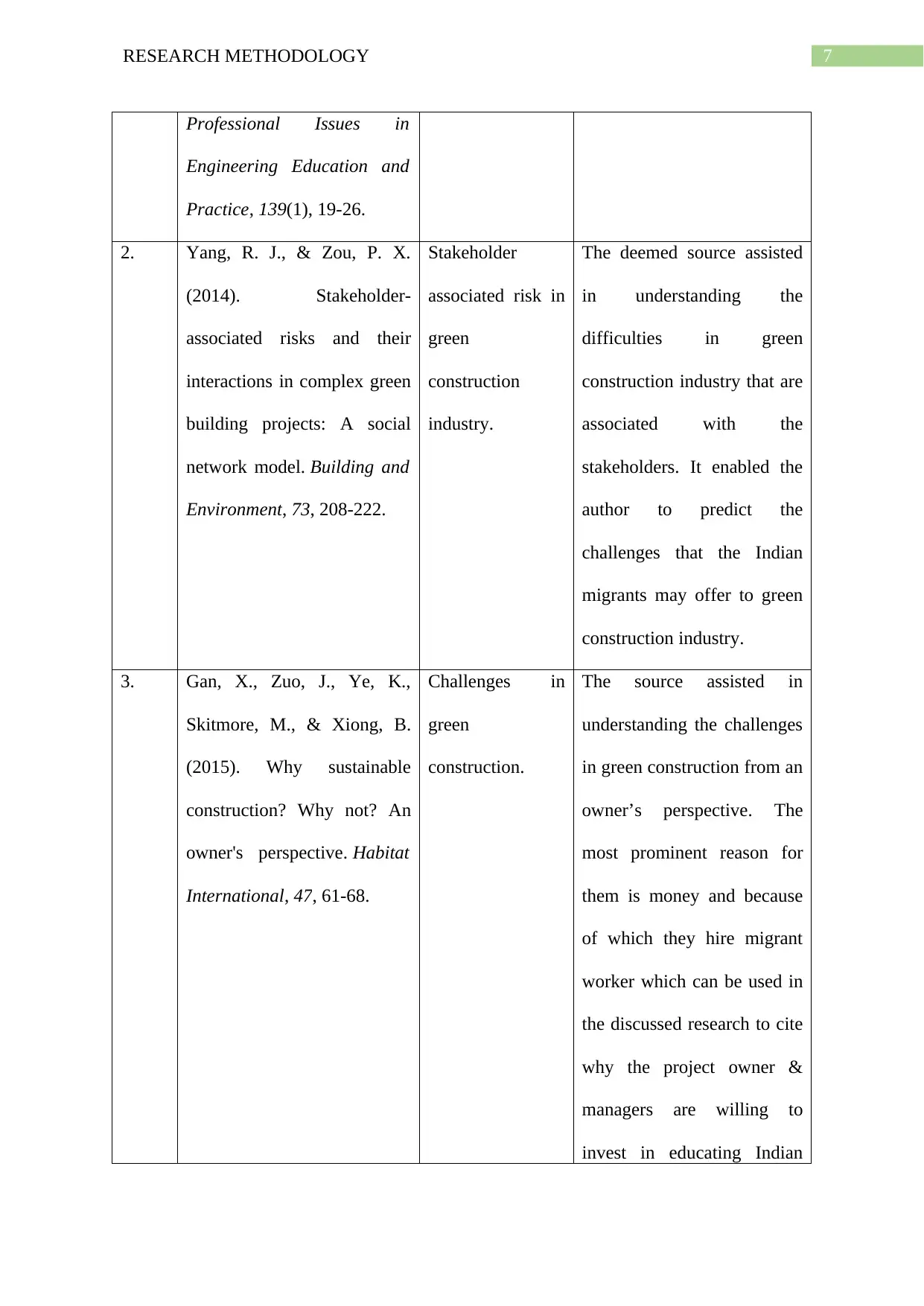
7RESEARCH METHODOLOGY
Professional Issues in
Engineering Education and
Practice, 139(1), 19-26.
2. Yang, R. J., & Zou, P. X.
(2014). Stakeholder-
associated risks and their
interactions in complex green
building projects: A social
network model. Building and
Environment, 73, 208-222.
Stakeholder
associated risk in
green
construction
industry.
The deemed source assisted
in understanding the
difficulties in green
construction industry that are
associated with the
stakeholders. It enabled the
author to predict the
challenges that the Indian
migrants may offer to green
construction industry.
3. Gan, X., Zuo, J., Ye, K.,
Skitmore, M., & Xiong, B.
(2015). Why sustainable
construction? Why not? An
owner's perspective. Habitat
International, 47, 61-68.
Challenges in
green
construction.
The source assisted in
understanding the challenges
in green construction from an
owner’s perspective. The
most prominent reason for
them is money and because
of which they hire migrant
worker which can be used in
the discussed research to cite
why the project owner &
managers are willing to
invest in educating Indian
Professional Issues in
Engineering Education and
Practice, 139(1), 19-26.
2. Yang, R. J., & Zou, P. X.
(2014). Stakeholder-
associated risks and their
interactions in complex green
building projects: A social
network model. Building and
Environment, 73, 208-222.
Stakeholder
associated risk in
green
construction
industry.
The deemed source assisted
in understanding the
difficulties in green
construction industry that are
associated with the
stakeholders. It enabled the
author to predict the
challenges that the Indian
migrants may offer to green
construction industry.
3. Gan, X., Zuo, J., Ye, K.,
Skitmore, M., & Xiong, B.
(2015). Why sustainable
construction? Why not? An
owner's perspective. Habitat
International, 47, 61-68.
Challenges in
green
construction.
The source assisted in
understanding the challenges
in green construction from an
owner’s perspective. The
most prominent reason for
them is money and because
of which they hire migrant
worker which can be used in
the discussed research to cite
why the project owner &
managers are willing to
invest in educating Indian
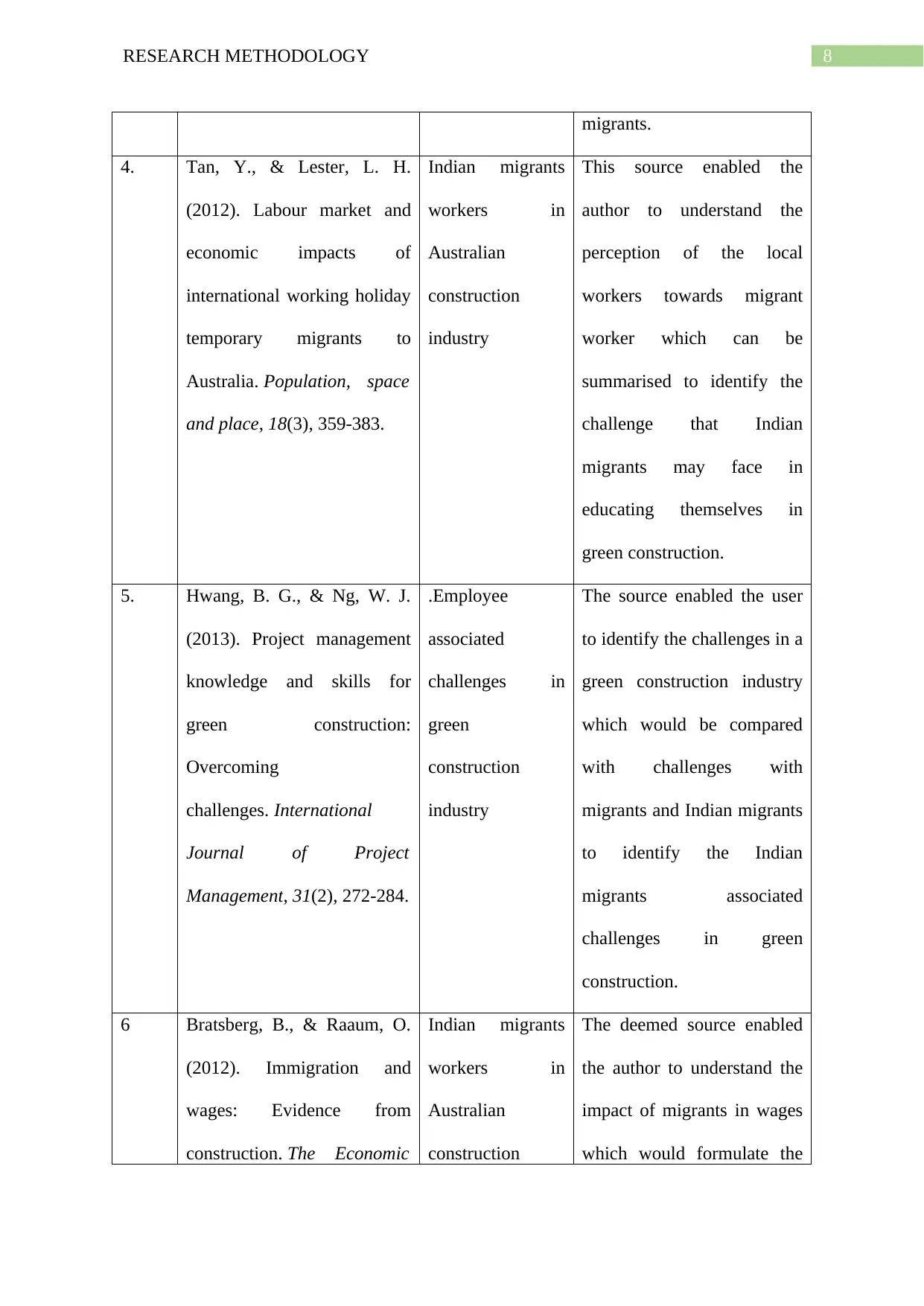
8RESEARCH METHODOLOGY
migrants.
4. Tan, Y., & Lester, L. H.
(2012). Labour market and
economic impacts of
international working holiday
temporary migrants to
Australia. Population, space
and place, 18(3), 359-383.
Indian migrants
workers in
Australian
construction
industry
This source enabled the
author to understand the
perception of the local
workers towards migrant
worker which can be
summarised to identify the
challenge that Indian
migrants may face in
educating themselves in
green construction.
5. Hwang, B. G., & Ng, W. J.
(2013). Project management
knowledge and skills for
green construction:
Overcoming
challenges. International
Journal of Project
Management, 31(2), 272-284.
.Employee
associated
challenges in
green
construction
industry
The source enabled the user
to identify the challenges in a
green construction industry
which would be compared
with challenges with
migrants and Indian migrants
to identify the Indian
migrants associated
challenges in green
construction.
6 Bratsberg, B., & Raaum, O.
(2012). Immigration and
wages: Evidence from
construction. The Economic
Indian migrants
workers in
Australian
construction
The deemed source enabled
the author to understand the
impact of migrants in wages
which would formulate the
migrants.
4. Tan, Y., & Lester, L. H.
(2012). Labour market and
economic impacts of
international working holiday
temporary migrants to
Australia. Population, space
and place, 18(3), 359-383.
Indian migrants
workers in
Australian
construction
industry
This source enabled the
author to understand the
perception of the local
workers towards migrant
worker which can be
summarised to identify the
challenge that Indian
migrants may face in
educating themselves in
green construction.
5. Hwang, B. G., & Ng, W. J.
(2013). Project management
knowledge and skills for
green construction:
Overcoming
challenges. International
Journal of Project
Management, 31(2), 272-284.
.Employee
associated
challenges in
green
construction
industry
The source enabled the user
to identify the challenges in a
green construction industry
which would be compared
with challenges with
migrants and Indian migrants
to identify the Indian
migrants associated
challenges in green
construction.
6 Bratsberg, B., & Raaum, O.
(2012). Immigration and
wages: Evidence from
construction. The Economic
Indian migrants
workers in
Australian
construction
The deemed source enabled
the author to understand the
impact of migrants in wages
which would formulate the
⊘ This is a preview!⊘
Do you want full access?
Subscribe today to unlock all pages.

Trusted by 1+ million students worldwide
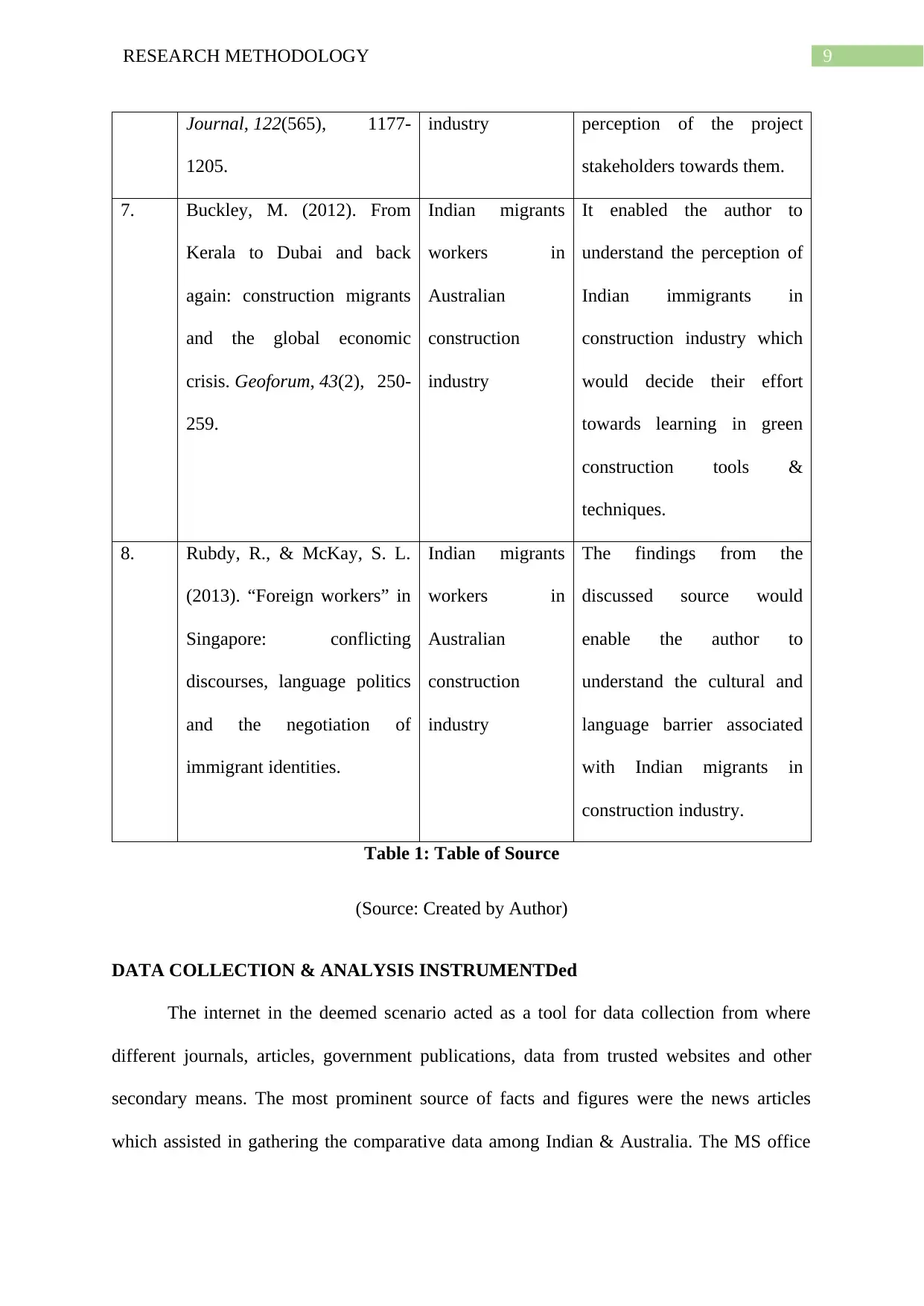
9RESEARCH METHODOLOGY
Journal, 122(565), 1177-
1205.
industry perception of the project
stakeholders towards them.
7. Buckley, M. (2012). From
Kerala to Dubai and back
again: construction migrants
and the global economic
crisis. Geoforum, 43(2), 250-
259.
Indian migrants
workers in
Australian
construction
industry
It enabled the author to
understand the perception of
Indian immigrants in
construction industry which
would decide their effort
towards learning in green
construction tools &
techniques.
8. Rubdy, R., & McKay, S. L.
(2013). “Foreign workers” in
Singapore: conflicting
discourses, language politics
and the negotiation of
immigrant identities.
Indian migrants
workers in
Australian
construction
industry
The findings from the
discussed source would
enable the author to
understand the cultural and
language barrier associated
with Indian migrants in
construction industry.
Table 1: Table of Source
(Source: Created by Author)
DATA COLLECTION & ANALYSIS INSTRUMENTDed
The internet in the deemed scenario acted as a tool for data collection from where
different journals, articles, government publications, data from trusted websites and other
secondary means. The most prominent source of facts and figures were the news articles
which assisted in gathering the comparative data among Indian & Australia. The MS office
Journal, 122(565), 1177-
1205.
industry perception of the project
stakeholders towards them.
7. Buckley, M. (2012). From
Kerala to Dubai and back
again: construction migrants
and the global economic
crisis. Geoforum, 43(2), 250-
259.
Indian migrants
workers in
Australian
construction
industry
It enabled the author to
understand the perception of
Indian immigrants in
construction industry which
would decide their effort
towards learning in green
construction tools &
techniques.
8. Rubdy, R., & McKay, S. L.
(2013). “Foreign workers” in
Singapore: conflicting
discourses, language politics
and the negotiation of
immigrant identities.
Indian migrants
workers in
Australian
construction
industry
The findings from the
discussed source would
enable the author to
understand the cultural and
language barrier associated
with Indian migrants in
construction industry.
Table 1: Table of Source
(Source: Created by Author)
DATA COLLECTION & ANALYSIS INSTRUMENTDed
The internet in the deemed scenario acted as a tool for data collection from where
different journals, articles, government publications, data from trusted websites and other
secondary means. The most prominent source of facts and figures were the news articles
which assisted in gathering the comparative data among Indian & Australia. The MS office
Paraphrase This Document
Need a fresh take? Get an instant paraphrase of this document with our AI Paraphraser
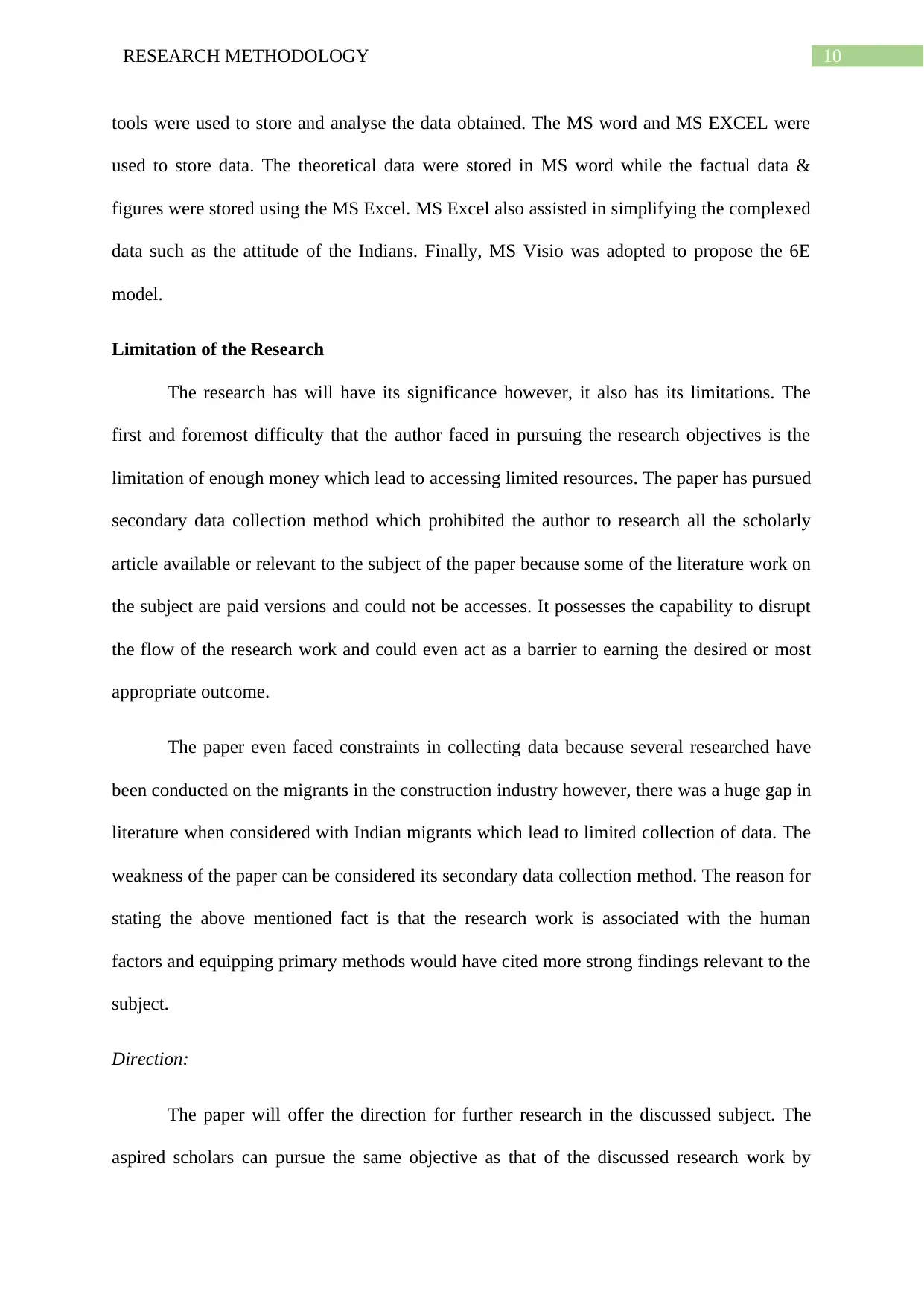
10RESEARCH METHODOLOGY
tools were used to store and analyse the data obtained. The MS word and MS EXCEL were
used to store data. The theoretical data were stored in MS word while the factual data &
figures were stored using the MS Excel. MS Excel also assisted in simplifying the complexed
data such as the attitude of the Indians. Finally, MS Visio was adopted to propose the 6E
model.
Limitation of the Research
The research has will have its significance however, it also has its limitations. The
first and foremost difficulty that the author faced in pursuing the research objectives is the
limitation of enough money which lead to accessing limited resources. The paper has pursued
secondary data collection method which prohibited the author to research all the scholarly
article available or relevant to the subject of the paper because some of the literature work on
the subject are paid versions and could not be accesses. It possesses the capability to disrupt
the flow of the research work and could even act as a barrier to earning the desired or most
appropriate outcome.
The paper even faced constraints in collecting data because several researched have
been conducted on the migrants in the construction industry however, there was a huge gap in
literature when considered with Indian migrants which lead to limited collection of data. The
weakness of the paper can be considered its secondary data collection method. The reason for
stating the above mentioned fact is that the research work is associated with the human
factors and equipping primary methods would have cited more strong findings relevant to the
subject.
Direction:
The paper will offer the direction for further research in the discussed subject. The
aspired scholars can pursue the same objective as that of the discussed research work by
tools were used to store and analyse the data obtained. The MS word and MS EXCEL were
used to store data. The theoretical data were stored in MS word while the factual data &
figures were stored using the MS Excel. MS Excel also assisted in simplifying the complexed
data such as the attitude of the Indians. Finally, MS Visio was adopted to propose the 6E
model.
Limitation of the Research
The research has will have its significance however, it also has its limitations. The
first and foremost difficulty that the author faced in pursuing the research objectives is the
limitation of enough money which lead to accessing limited resources. The paper has pursued
secondary data collection method which prohibited the author to research all the scholarly
article available or relevant to the subject of the paper because some of the literature work on
the subject are paid versions and could not be accesses. It possesses the capability to disrupt
the flow of the research work and could even act as a barrier to earning the desired or most
appropriate outcome.
The paper even faced constraints in collecting data because several researched have
been conducted on the migrants in the construction industry however, there was a huge gap in
literature when considered with Indian migrants which lead to limited collection of data. The
weakness of the paper can be considered its secondary data collection method. The reason for
stating the above mentioned fact is that the research work is associated with the human
factors and equipping primary methods would have cited more strong findings relevant to the
subject.
Direction:
The paper will offer the direction for further research in the discussed subject. The
aspired scholars can pursue the same objective as that of the discussed research work by
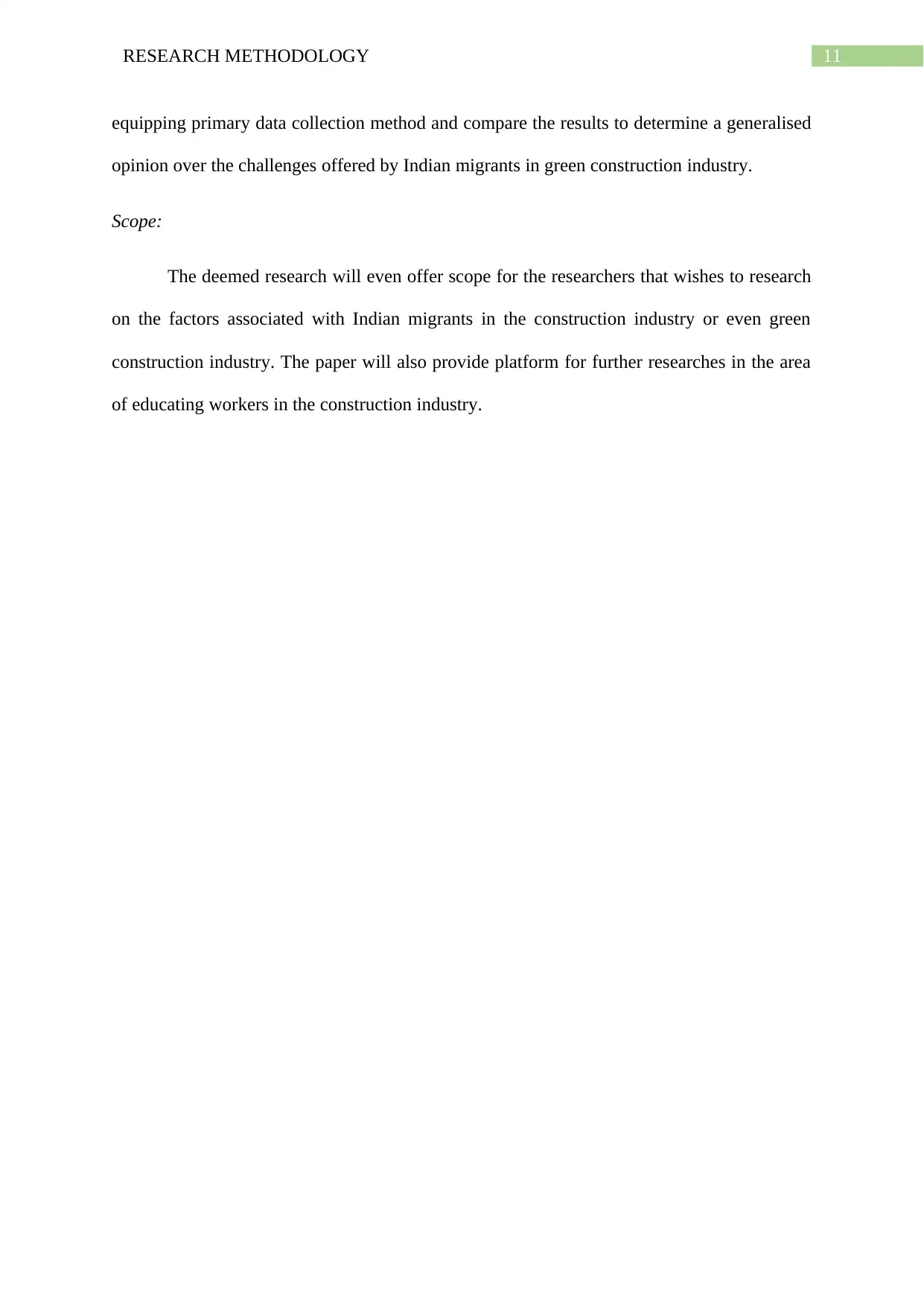
11RESEARCH METHODOLOGY
equipping primary data collection method and compare the results to determine a generalised
opinion over the challenges offered by Indian migrants in green construction industry.
Scope:
The deemed research will even offer scope for the researchers that wishes to research
on the factors associated with Indian migrants in the construction industry or even green
construction industry. The paper will also provide platform for further researches in the area
of educating workers in the construction industry.
equipping primary data collection method and compare the results to determine a generalised
opinion over the challenges offered by Indian migrants in green construction industry.
Scope:
The deemed research will even offer scope for the researchers that wishes to research
on the factors associated with Indian migrants in the construction industry or even green
construction industry. The paper will also provide platform for further researches in the area
of educating workers in the construction industry.
⊘ This is a preview!⊘
Do you want full access?
Subscribe today to unlock all pages.

Trusted by 1+ million students worldwide
1 out of 12
Related Documents
Your All-in-One AI-Powered Toolkit for Academic Success.
+13062052269
info@desklib.com
Available 24*7 on WhatsApp / Email
![[object Object]](/_next/static/media/star-bottom.7253800d.svg)
Unlock your academic potential
Copyright © 2020–2025 A2Z Services. All Rights Reserved. Developed and managed by ZUCOL.





